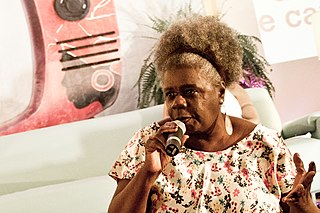
Samba is a name or prefix used for several rhythmic variants, such as samba urbano carioca, samba de roda, recognized as part of the Intangible Cultural Heritage of Humanity by UNESCO, amongst many other forms of samba, mostly originated in the Rio de Janeiro and Bahia states.

Christ the Redeemer is an Art Deco statue of Jesus Christ in Rio de Janeiro, Brazil, created by French-Polish sculptor Paul Landowski and built by Brazilian engineer Heitor da Silva Costa, in collaboration with French engineer Albert Caquot. Romanian sculptor Gheorghe Leonida sculpted the face. Constructed between 1922 and 1931, the statue is 30 metres (98 ft) high, excluding its 8-metre (26 ft) pedestal. The arms stretch 28 metres (92 ft) wide. It is made of reinforced concrete and soapstone. Christ The Redeemer differs considerably from its original design, as the initial plan was a large Christ with a globe in one hand and a cross in the other. Although the project organisers originally accepted the design, it later changed to the statue of today, with the arms spread out wide.

José Bonifácio de Andrada e Silva was a Brazilian statesman, naturalist, mineralist, professor and poet, born in Santos, São Paulo, then part of the Portuguese Empire.

Fernando Tavares Sabino was a Brazilian writer and journalist.
Brígida Baltar was a Brazilian visual artist. Her work spanned across a wide range of mediums, including video, performance, installation, drawing, and sculpture. She was interested in capturing the ephemeral in her artwork.

The Brazilian Historic and Geographic Institute, IHGB, founded on 21 October 1838, is the oldest and traditional authority to promote research and preservation of historical and geographical, cultural and social sciences in Brazil. Its creation, together with the Public Archives of Empire, which amounted to the Imperial Academy of Fine Arts, joined the effort of the conservatives during the regency of Pedro de Araújo Lima to build a strong and centralized imperial state.
Companhia Itaú de Transportes Aéreos was a Brazilian airline founded in 1947. In 1955 it was sold to Transportes Aéreos Nacional, which incorporated the airline the following year.

Muriqui is a district of the municipality of Mangaratiba, located within the Greater Rio de Janeiro, Brazil. It is part of the Green Coast. Highway BR-101 passes through the district.

The Pantheon of the House of Braganza, also known as the Pantheon of the Braganzas, is the final resting place for many of the members of the House of Braganza, located in the Monastery of São Vicente de Fora in the Alfama district of Lisbon, Portugal. The pantheon's burials have included Portuguese monarchs, Brazilian monarchs, a Romanian monarch, queen consorts of Portugal, and notable Infantes of Portugal, among others.

The Monument to the Independence of Brazil is a granite and bronze monument located in the Independence Park in São Paulo, Brazil. It is also known as the Ipiranga Monument or the Altar of the Fatherland. The monument is located on the banks of the Ipiranga Brook, on the historic site where prince regent Pedro proclaimed the independence of the country on 7 September 1822.

Marcelo Moraes Caetano is a Brazilian writer, professor, critic, pianist, and journalist.

Events in the year 1908 in Brazil.
Orfeu da Conceição is a stage play with music in three acts by Vinicius de Moraes and music by Antônio Carlos Jobim that premiered in 1956 in Rio de Janeiro. The play became the basis for the films Orfeu Negro and Orfeu (1999), and for the musicals Orfeu and Black Orpheus.

Antônio Carlos Moreira Pires, better known as Moraes Moreira, was a Brazilian musician and songwriter. During the 1970s he played guitar and sang in the band Novos Baianos, after which he embarked on a solo career recording 29 albums. Moreira was involved in recording 40 full-length albums with Novos Baianos and Trio Elétrico Dodô e Osmar, and two more albums with guitarist Pepeu Gomes. Moreira was one of the most versatile composers of Brazil, mixing the genres of rock, samba, choro, frevo, baião, and classical.

Maria da Conceição Evaristo de Brito is a Brazilian writer. Her work is marked by her life experiences as an Afro-Brazilian woman, which she calls escrevivência—a portmanteau of escrita (writing) and vivência. She was born into a humble family and is the second oldest of 9 siblings, being the first in her household to earn a university degree. She helped her mother and aunt with washing clothes and deliveries, while studying.

Clube de Regatas do Flamengo, commonly known as Flamengo, is a professional women's association football club based in Rio de Janeiro, Brazil. Founded in 1995, the team is affiliated with FFERJ and play their home games at Estádio da Gávea. The team colors, reflected in their logo and uniform, are red and black. They play in the top tier of women's football in Brazil, the Campeonato Brasileiro de Futebol Feminino, and in the Campeonato Carioca de Futebol Feminino, the first division of the traditional in-state competition. Their players belong to the Brazilian Navy, which has formed a partnership with the team in 2015.

Mariza Dias Costa was a Guatemalan-Brazilian political cartoonist and illustrator who influenced her genre with her novel approach.
Angela Freiberger is a Brazilian artist from Rio de Janeiro. She is best known for works that emphasize the relation between sculpture and performance.
Leila Míccolis is a Brazilian poet, essayist, novelist, short story writer, screenwriter, playwright, and editor.

Edino Krieger was a Brazilian avant-garde composer, conductor, record producer and musical critic.
















